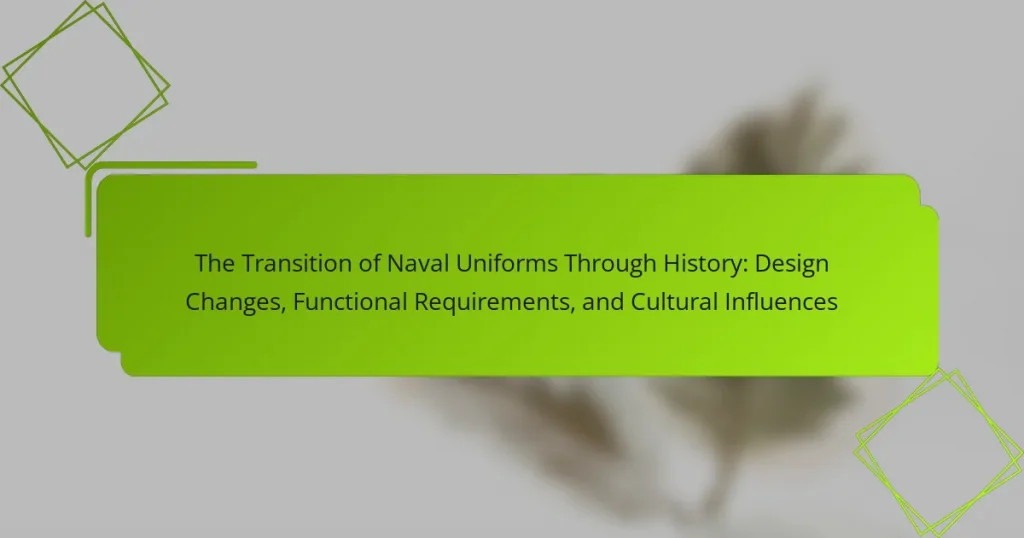Naval uniforms have undergone significant changes throughout history, reflecting various functional requirements and cultural influences. Key milestones include the introduction of standardized uniforms in the 17th century, the British Royal Navy’s formal uniform in 1748, and the evolution of practical designs in the 19th century, such as the frock coat. The late 19th century marked a shift towards national identity in uniform design, while the 20th century introduced modern materials and unisex options. The article examines how naval uniforms blend military tradition with practical needs and cultural symbolism, adapting to technological advancements and societal changes over time.

What are the key historical milestones in the transition of naval uniforms?
The transition of naval uniforms has several key historical milestones. In the 17th century, the introduction of standardized uniforms began in various navies. The British Royal Navy adopted a formal uniform in 1748, establishing a model for others. In the early 19th century, naval uniforms became more practical, incorporating elements like epaulettes for rank distinction. The 1850s saw the introduction of the “frock coat” style, which was more functional for sailors. By the late 19th century, naval uniforms began to reflect national identities, incorporating unique insignias and colors. The 20th century introduced more modern materials, enhancing comfort and functionality. Post-World War II, uniforms evolved to include unisex designs, reflecting changing societal norms. Today, naval uniforms continue to adapt to technological advancements and operational needs.
How did naval uniforms evolve from ancient times to the modern era?
Naval uniforms evolved significantly from ancient times to the modern era. In ancient civilizations, such as Greece and Rome, naval attire was primarily functional, designed for mobility and combat. These early uniforms often consisted of simple tunics and armor. By the Middle Ages, naval uniforms began to incorporate distinctive colors and insignia to signify rank and allegiance.
The 17th century saw the introduction of more structured uniforms, influenced by European military styles. Sailors wore coats and trousers, often in navy blue, which became a standard color. The British Royal Navy formalized naval uniforms in the 18th century, introducing regulations for design and fabric.
In the 19th century, uniforms became more standardized across navies worldwide. The introduction of the double-breasted jacket and epaulettes marked a shift towards a more formal appearance. The 20th century brought further changes, with uniforms adapting to technological advancements and practical needs, such as the introduction of waterproof materials.
Today, modern naval uniforms vary by country but often include elements that reflect tradition while prioritizing functionality and comfort. The evolution of naval uniforms reflects broader social and cultural changes throughout history.
What were the primary influences on early naval uniform designs?
Early naval uniform designs were primarily influenced by practicality, tradition, and military hierarchy. Practicality dictated the use of durable materials suitable for maritime conditions. Traditional influences stemmed from the clothing of land armies and the need for sailors to be easily identifiable. Military hierarchy played a role in distinguishing ranks through specific colors and insignia. These factors combined to create uniforms that were functional, recognizable, and reflective of the naval culture of the time.
How did technological advancements impact naval uniform materials?
Technological advancements significantly transformed naval uniform materials. The introduction of synthetic fabrics improved durability and comfort. Innovations in textile manufacturing allowed for lighter and more breathable materials. These advancements also enhanced water resistance, crucial for naval operations. For example, the development of nylon in the mid-20th century offered superior strength and quick-drying properties. Additionally, advancements in dye technology enabled vibrant colors that maintained their appearance over time. Overall, these changes increased the functionality and longevity of naval uniforms, adapting to the evolving demands of maritime environments.
What role did naval uniforms play in establishing identity and hierarchy?
Naval uniforms played a crucial role in establishing identity and hierarchy within naval forces. They visually distinguished ranks and roles among personnel. Different uniform styles and insignia indicated various ranks, enhancing command structure clarity. This differentiation fostered unity and pride among sailors. Historical evidence shows that specific colors and designs were often mandated by naval regulations. For example, the British Royal Navy established a system of uniforms in the 18th century to signify rank and duty. Such regulations ensured that personnel were easily identifiable during operations. The use of uniforms also promoted discipline and a sense of belonging to a larger institution. Overall, naval uniforms were fundamental in reinforcing both individual identity and organizational hierarchy.
How did color and insignia choices reflect rank and status?
Color and insignia choices in naval uniforms directly reflected rank and status. Different colors indicated varying levels of authority and responsibility. For example, higher-ranking officers often wore distinctive colors, such as navy blue or gold, to signify their elevated position. Insignia, including badges and stripes, provided visual cues to identify rank quickly. Historically, these elements helped maintain order and discipline within naval ranks. The use of specific colors and insignia has roots in military tradition, where visual differentiation was essential for command recognition. This system of color and insignia has evolved but remains a key aspect of naval uniforms today.
What cultural factors influenced the design of naval uniforms in different countries?
Cultural factors significantly influenced the design of naval uniforms across different countries. National identity plays a crucial role in uniform design. Countries often incorporate national colors and symbols into their naval attire. Historical traditions also shape uniform styles, reflecting a nation’s maritime history. For instance, British naval uniforms evolved from the 17th century, showcasing a blend of practicality and tradition. In contrast, countries like Japan emphasize ceremonial aspects in their naval uniforms, reflecting cultural values of honor and discipline. Additionally, climate influences material choices and uniform styles, as seen in tropical nations opting for lighter fabrics. These cultural elements collectively define the unique characteristics of naval uniforms worldwide.

What are the functional requirements of naval uniforms throughout history?
Naval uniforms throughout history have required functionality in various aspects. They must provide protection against harsh weather conditions. Durability is essential for uniforms to withstand the rigors of naval service. Visibility is crucial for safety during operations at sea. Comfort is necessary to allow for ease of movement while performing duties. Uniforms also serve a symbolic purpose, representing rank and unity among personnel. Historical examples include wool uniforms for warmth in the 18th century and modern synthetic materials for moisture-wicking properties. Each era’s designs reflect the prevailing naval needs and technological advancements.
How have practical needs shaped the design of naval uniforms?
Practical needs have significantly shaped the design of naval uniforms throughout history. These uniforms must provide functionality, safety, and comfort for personnel. For example, the use of durable materials protects sailors from harsh weather conditions. The incorporation of pockets and fastenings facilitates the carrying of essential tools and equipment. Additionally, designs often prioritize ease of movement for physical tasks aboard ships. Historical contexts, such as the introduction of steam power, required uniforms to adapt for different duties. Safety features, like high-visibility colors, enhance crew visibility during operations. Overall, the evolution of naval uniforms reflects a balance between practicality and military tradition.
What specific functions do naval uniforms serve in various maritime environments?
Naval uniforms serve multiple specific functions in various maritime environments. They provide identification, indicating rank and affiliation within the navy. Uniforms enhance safety by incorporating materials that are flame-resistant and quick-drying. They also offer protection from environmental elements like saltwater and extreme temperatures.
Additionally, uniforms promote discipline and unity among personnel. This fosters a sense of belonging and enhances team cohesion. The design may vary based on operational needs, such as camouflage for specific missions or formal attire for ceremonial occasions.
Historically, naval uniforms have evolved to meet the practical demands of different maritime environments. For instance, the introduction of synthetic fibers improved durability and comfort. Overall, naval uniforms are essential for functionality, safety, and representation in maritime operations.
How have safety and comfort considerations evolved in naval uniform design?
Safety and comfort considerations in naval uniform design have significantly evolved over time. Early naval uniforms prioritized durability and visibility for identification. As naval warfare technology advanced, materials began to incorporate fire-resistant and water-repellent features. Modern designs now focus on ergonomic fit and moisture-wicking fabrics for enhanced comfort. The introduction of high-tech materials has improved protection against environmental hazards. Additionally, uniforms are now tailored to allow for better movement and flexibility. Regulations have also shifted to include guidelines for psychological comfort, recognizing the impact of uniform design on morale. These changes reflect a comprehensive approach to the well-being of naval personnel in various operational environments.
What innovations have been introduced to enhance uniform functionality?
Innovations to enhance uniform functionality in naval attire include the integration of moisture-wicking fabrics. These materials improve comfort by keeping sailors dry during physical activities. Additionally, the introduction of modular designs allows for easy customization based on mission requirements. This adaptability enhances the uniform’s usability in various environments.
Reflective materials have also been incorporated for improved visibility during low-light conditions. These features ensure safety and compliance with operational standards. Furthermore, the use of lightweight, durable textiles reduces fatigue during extended wear. Innovations like reinforced seams increase the longevity of uniforms in demanding conditions.
The adoption of advanced technologies, such as built-in temperature regulation systems, enhances comfort in diverse climates. These innovations reflect ongoing efforts to balance functionality with the operational needs of naval personnel.
How do modern materials improve the performance of naval uniforms?
Modern materials enhance the performance of naval uniforms through improved durability, comfort, and functionality. Advanced synthetic fabrics resist wear and tear better than traditional materials. These fabrics provide moisture-wicking properties, keeping sailors dry in various conditions. Additionally, modern materials often include UV protection, shielding personnel from harmful sun exposure. Lightweight designs reduce fatigue during long missions. Furthermore, fire-resistant materials ensure safety in hazardous environments. Research indicates that uniforms made from these advanced materials can enhance overall operational effectiveness. Studies show that improved comfort leads to better focus and performance in critical situations.
What are the latest trends in ergonomic design for naval uniforms?
The latest trends in ergonomic design for naval uniforms focus on enhanced mobility and comfort. Innovations include the use of stretchable fabrics to allow for greater range of motion. Additionally, moisture-wicking materials are being incorporated to improve breathability. Ergonomic tailoring techniques are being employed to fit the uniform to the body more naturally. This minimizes discomfort during extended wear. Reinforced seams and strategic padding are also trending to provide durability and support. These advancements are informed by feedback from active personnel regarding performance needs. Overall, these trends aim to increase functionality and adaptability in various maritime environments.

What cultural influences have shaped naval uniforms over time?
Naval uniforms have been shaped by various cultural influences throughout history. Traditional military aesthetics have played a significant role in their design. The British Royal Navy influenced naval uniforms globally in the 18th and 19th centuries. Their adoption of distinct colors and patterns set a precedent for other navies.
Maritime traditions also contributed to uniform styles. Elements such as the sailor’s collar and bell-bottomed trousers originated from practical needs at sea. Cultural symbolism is evident in insignia and colors representing national identity.
In the 20th century, world events altered naval uniforms. The introduction of modern materials reflected technological advancements. Globalization has led to more standardized designs across different navies.
Overall, naval uniforms are a blend of military tradition, practical needs, and cultural symbolism, evolving with societal changes.
How do national identities manifest in naval uniform designs?
National identities manifest in naval uniform designs through distinctive colors, symbols, and styles. Each nation incorporates unique elements that reflect its culture and history. For example, the British Royal Navy uses navy blue and white, symbolizing tradition and authority. The United States Navy features a mix of dark blue and gold, representing strength and honor. Additionally, many countries include national emblems or flags on uniforms to signify allegiance. Historical influences also shape designs; for instance, the introduction of modern materials reflects technological advancements. Overall, naval uniforms serve as a visual representation of national pride and identity.
What historical events have influenced changes in naval uniform styles?
Naval uniform styles have changed significantly due to various historical events. The Napoleonic Wars prompted the adoption of standardized uniforms for better identification. The introduction of steam-powered ships in the 19th century led to more practical designs, prioritizing comfort and functionality. World War I saw the implementation of more utilitarian garments, reflecting the need for durability. The interwar period influenced naval fashion with the introduction of more modern materials. World War II brought about camouflage patterns to enhance concealment. The Cold War era emphasized a more formal appearance, reflecting military professionalism. Recent conflicts have led to the integration of tactical gear into naval uniforms for operational efficiency. These events collectively shaped the evolution of naval uniform styles over time.
How do naval uniforms reflect broader societal values and norms?
Naval uniforms reflect broader societal values and norms by symbolizing authority, discipline, and national identity. The design of these uniforms often incorporates elements that represent a nation’s heritage and military traditions. For example, the use of specific colors and insignia can signify rank and branch of service, illustrating a structured hierarchy that mirrors societal organization.
Historically, naval uniforms have evolved in response to changing societal attitudes towards military service and patriotism. In the 19th century, uniforms became more elaborate, reflecting the importance of military prestige during imperial expansion. In contrast, modern uniforms emphasize functionality and practicality, aligning with contemporary values of efficiency and service.
Additionally, the adoption of gender-neutral designs in recent years highlights evolving societal norms regarding gender roles within the military. This shift indicates a broader acceptance of diversity and inclusion in service. Overall, naval uniforms serve as a visual representation of the values and norms that define a society’s relationship with its military forces.
What is the significance of ceremonial uniforms in naval traditions?
Ceremonial uniforms in naval traditions signify honor, discipline, and professionalism. These uniforms represent a visual embodiment of naval heritage and identity. They serve to distinguish ranks and roles within the naval hierarchy. Ceremonial uniforms are often worn during significant events, enhancing the solemnity of the occasion. Historically, these uniforms have evolved to reflect changes in naval culture and societal values. They also foster unity and camaraderie among service members. Ceremonial attire often incorporates symbols and insignia that convey pride and tradition. The use of specific colors and designs can also denote historical significance and regional influences.
How do ceremonial uniforms differ from operational uniforms?
Ceremonial uniforms differ from operational uniforms primarily in their purpose and design. Ceremonial uniforms are worn during formal events and ceremonies. They often feature elaborate designs, embellishments, and specific insignia. Operational uniforms are designed for functionality and practicality in various working environments. They prioritize comfort, durability, and ease of movement. Ceremonial uniforms may include items like dress hats and medals, while operational uniforms typically do not. The distinction is evident in military practices, where ceremonial uniforms represent tradition and pride. Operational uniforms reflect the need for efficiency and safety in active duty.
What role do uniforms play in naval ceremonies and public perception?
Uniforms in naval ceremonies symbolize authority and professionalism. They create a visual representation of the naval identity. The distinct styles and colors signify rank and role within the naval hierarchy. Uniforms enhance the ceremonial atmosphere, fostering respect and discipline. Public perception is influenced by the presentation of naval personnel in uniform. Ceremonial uniforms contribute to national pride and collective memory. Historical events, such as fleet reviews, showcase the significance of uniforms. The consistent evolution of naval uniforms reflects cultural and functional changes over time.
What are the best practices for maintaining and caring for naval uniforms?
To maintain and care for naval uniforms, follow established best practices. Regularly inspect uniforms for wear and tear. Clean uniforms according to the care label instructions. Use mild detergents to prevent fabric damage. Store uniforms in a cool, dry place to avoid mildew. Iron uniforms as needed to maintain a crisp appearance. Ensure proper folding or hanging to prevent creases. Repair any damages promptly to prolong the uniform’s life. Adhering to these practices ensures uniforms remain in optimal condition for service.
How should different materials be cleaned and stored to ensure longevity?
Different materials should be cleaned and stored according to their specific properties to ensure longevity. Natural fibers like cotton and wool should be washed in cold water and air-dried to prevent shrinkage and damage. Synthetic fabrics, such as polyester, can be machine washed in warm water but should avoid high heat in the dryer. Leather materials require gentle cleaning with a damp cloth and should be conditioned regularly to maintain suppleness.
For storage, cotton and wool should be kept in breathable cotton bags to prevent moisture buildup. Synthetic fabrics can be stored in plastic containers to protect against dust. Leather should be stored in a cool, dry place away from direct sunlight to prevent fading and cracking. Proper cleaning and storage practices extend the lifespan of naval uniforms significantly, as evidenced by their historical preservation in museums.
What common issues should be addressed when caring for naval uniforms?
Common issues when caring for naval uniforms include proper cleaning, maintenance of fabric integrity, and avoidance of damage. Naval uniforms often require specific washing instructions to maintain color and fabric quality. Frequent exposure to saltwater can lead to deterioration, necessitating regular inspections for wear and tear. Ironing and pressing should be done carefully to preserve the uniform’s shape and appearance. Stains from food or oil should be treated promptly to prevent permanent damage. Additionally, proper storage is crucial to prevent creasing or moth damage. Ensuring all insignia and badges are securely attached is also important for uniform integrity.
The main entity of the article is naval uniforms, exploring their historical transition from ancient times to the modern era. Key milestones include the introduction of standardized designs in the 17th century, the formalization by the British Royal Navy in the 18th century, and the evolution of materials and functionality driven by technological advancements. The article discusses the influences of culture, rank, and societal norms on uniform design, as well as the practical requirements for safety and comfort in various maritime environments. Additionally, it addresses the significance of ceremonial uniforms and best practices for their maintenance and care.




